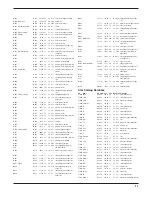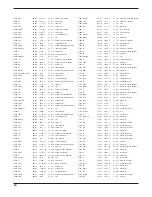
7
The
NGC Catalog is the New General Catalog of deep-sky
objects complied by the Danish astronomer J.L.E. Dreyer
more than 100 years ago. It contains hundreds of excellent
examples of each type of deep-sky object and is the most well
known and used catalog by amateur astronomers beyond the
already mentioned Messier (
M) Catalog.
The
IC Catalog, the Index Catalog, contains objects which
were discovered in the decade or so after the NGC was first
published. This list contains objects similar to the NGC, but the
IC objects are typically fainter and more difficult to observe.
The
NEW (User’s) Catalog is initially empty. It may be used
to store the coordinates of the observer’s favorite objects, for
current positions of an unexpected comet or nova, or for a
variable star observing list. There is space for 27 objects in
the memory. The objects are kept in memory even when
power is turned off.
First the object number is set in the same manner as selecting
any catalog object. After the object is selected, press ENTER
and the coordinates will be displayed. If you want to change the
coordinates press ENTER again. The first digit of the coordi-
nates will blink, this digit may be changed by pressing the UP
and DOWN buttons to increment or decrement the digit. When
the first digit is set press ENTER to go on to the next digit.
Should you decide not to change the coordinates, press MODE
to exit. When you have finished setting the digits, press
ENTER, then MODE to exit or UP or DOWN to go to another
entry in the catalog.
Example
CATALOG display for selecting an object from the
NEW catalog:
Enter number:
NEW15
Coordinates:
1930+275
The
PLANETS Catalog consists of the major planets of the
solar system. The planetary positions are calculated accord-
ing to the date. While the date is not required for any other
type of celestial subject, it is necessary for calculating correct
planet positions. Sky Wizard will remind you to enter the date
the first time you choose the Planets catalog during an
observing session.
Press MODE, scroll to
CATALOG, press ENTER. Scroll to
PLANETS and press ENTER. When DATE appears, press
ENTER twice. The last calendar date entered will be dis-
played. This date is used in the planetary orbit calculations.
The range of years is from 1950 to 2050. Press ENTER again.
The display order is Month, Date, and Year. The digits may be
set sequentially using the UP and DOWN buttons to set each
digit. Press ENTER when each digit is set to the desired
value. After setting all the digits of the date, press UP or
DOWN to select a planet.
The UP and DOWN buttons will allow you to scroll through the
list of planets. Press ENTER to display the current coordi-
nates of the planet.
The CATALOG display for selecting a planet:
MERCURY
VENUS
MARS
JUPITER
SATURN
URANUS
NEPTUNE
PLUTO
Find
The
FIND mode provides steering directions to a pre-selected
object in the catalog. Pick an object from any of the catalog
databases, then press MODE to return the mode selector,
and press UP or DOWN until
FIND is displayed, then press
ENTER. FIND takes the last object selected from the
CATALOG, compares the objects published coordinates with
the current telescope position, and displays steering direc-















